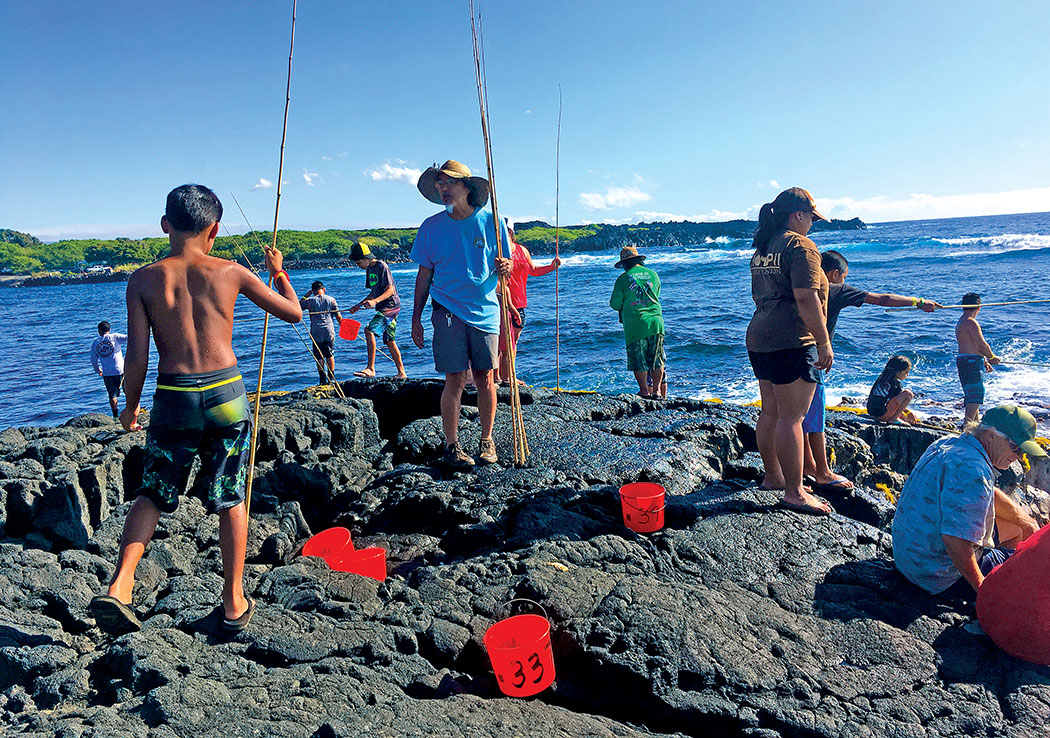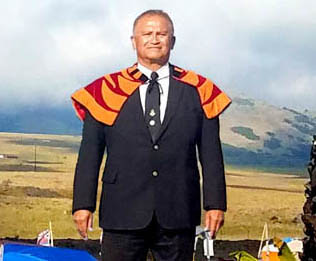Then & Now: Hawai‘i, Maui, and the ‘Alenuihāhā
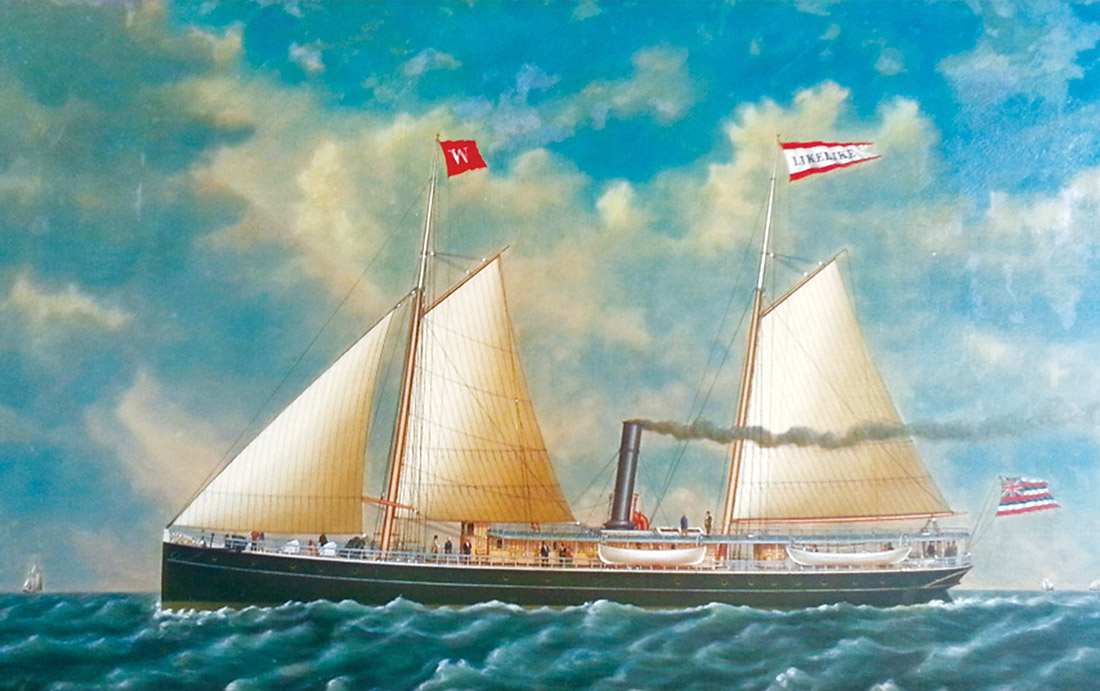
By Pete Hendricks
Prevailing winds travel thousands of miles east to west across the vast Pacific Ocean in the latitudes of the Hawaiian Islands. These winds are known as “tradewinds” for their ability to push sailing ships around the world in the early days of Pacific and Atlantic commerce. Winds approaching the gap between Hawai‘i and Maui meet a 26-mile opening, with high mountains on either side and a passage more than 7,000 feet deep. The result is ‘Alenuihāhā channel, respected by mariners for its sometimes ferocious seas and even occasional suspension of commercial interisland traffic.
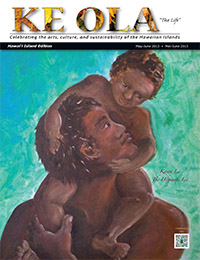
The well-deserved literal translation of “‘Alenuihāhā” in Pukui and Elbert’s Hawaiian Dictionary is “great billows smashing.” On any day, even with an “average” 10-20 mph tradewind from the northeast through the islands, by early afternoon ‘Alenuihāhā becomes a formidable crossing toward Maui, and a much bigger challenge coming upwind from Maui to Hawai‘i. The United States Coast Pilot notes: “Strong trade winds usually prevail, causing the channel to be very rough and a current of one to two knots to set W. Passage is very difficult for small vessels, especially when going E.” In the mid-1800s, the crack sailing schooner Mary could make it to Honolulu overnight, but on one passage upwind from Honolulu to Kawaihae (1857), the Mary took 57 hours, with a good portion of that struggling to windward across the ‘Alenuihāhā channel. Some kūpuna still talk about “going down to Honolulu,” because that direction is downwind (and more pleasant), even though Honolulu is North and West from here.
One of the rougher passages of similar width anywhere in the world, ‘Alenuihāhā channel was frequently traversed by Hawaiians in canoes even after they had ceased to travel far south across the Equator to and from their home islands. ‘Alenuihāhā both allows and impedes ocean travel between Hawai‘i and Maui. In the days of canoes, sail and paddle crossings had to coincide with the right weather. Even today, scheduled interisland commercial barge and shipping traffic can be suspended when ‘Alenuihāhā shows its fiercest seas and winds.
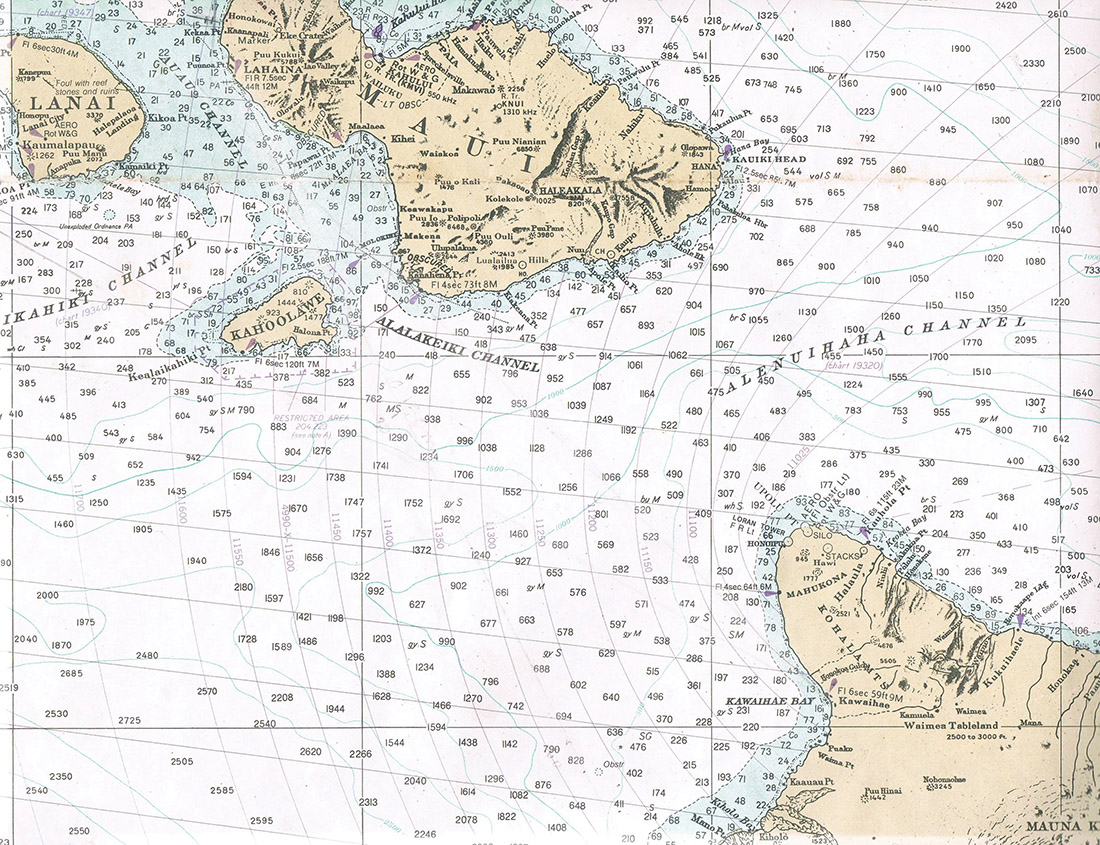
In early Hawaiian lore, Hi‘iaka, favorite younger sister of the goddess Pele, made one rare calm passage of the ‘Alenuihāhā in her canoe travels among the islands, and is said to have landed at Nu‘u, down channel from Hāna. Later, Umi, who ruled Hawai‘i island from 1600 to 1620, sent his trusted ali‘i Omaokamao to Maui to seek a wife. Omaokamao landed at Kapueokahi, near where the Ka‘uiki hill lighthouse stands today in Hāna. Pi‘ilani, the Maui ruler, agreed to the union, as did his daughter, Pi‘ikea, and the marriage was arranged, creating a familial and strategic link between the two islands. When Pi‘ikea sailed from Hāna for Waipio valley, about 400 canoes reportedly accompanied her on the upwind crossing. Umi, in support of his brother-in-law, later returned to Maui with a large war fleet to defeat another of Pi‘ikea’s brothers.
After one such canoe transit of ‘Alenuihāhā in 1778, the young ali‘i warrior Kamehameha I and his mentor Kekuhaupio arrived on Maui in support of Kamehameha’s ali‘i Uncle Kalaniopu‘u. The senior ali‘i was warring with his principal rival on Maui, Kahekili. The battles on Maui were bloody and costly to both sides. While on Maui, Kamehameha and Kekuhaupio encountered Captain James Cook and the Resolution at Wailua, on the windward channel side of Maui between Hāna and Kīpahulu. It was November of 1778, and Cook’s expedition had already been at sea since June of 1776, exploring Alaska, the Bering Sea, and the northwest coast in search of the sea passage east across America. Cook knew the position of his original landfall, Kaua‘i, and wanted to verify the locations of other Hawaiian islands as well as winter over and provision in warmer waters and moderate climate.

Bringing the Resolution close in to the windward Maui coast, Cook lay off the little bay of Wailua Iki. Captain Cook was cautious, as the Resolution was close to a “lee shore,” with winds generally pushing the ship toward the rocky coastline.
At Wailua Iki, many canoes came out to the Resolution. The Hawaiians were curious, relations were friendly, and the ship was in need of water and provisions.
Other ali‘i were fearful of the “great canoe,” which they called moku nui (great island), however Kamehameha took the opportunity to go aboard the Resolution and Kekuhaupio followed. Kamehameha was apparently not fearful of the thundering cannons demonstrated aboard Resolution, and reportedly said to Kekuhaupio: ”E Kekuhaupio e, do you understand the nature of this great canoe of the foreigner and of our little war canoes? Our canoes are like little pieces of wood alongside this great canoe of the foreigner. How shall we get a large canoe like this?” Kamehameha and his mentor stayed overnight on the Resolution as Cook took her offshore for safety during the night. The next morning, Kamehameha’s followers rejoiced at his return, as they thought he had been taken forever by the moku nui.
Years later, in 1794, with the help of Captain George Vancouver’s carpenters, Kamehameha built his first western vessel at Kealakekua Bay, a 36-footer called Beretane (Britain). In 1791, Kamehameha had used the captured schooner Fair American in the only major sea battle of his campaigns, against the Maui ali’i Kahekili off Polulu Valley, just southeast of ‘Alenuihāhā channel. Kamehameha went on to amass a fleet of hundreds of double war canoes, western “great canoes” and firearms in his eventual conquest of all the Hawaiian islands.
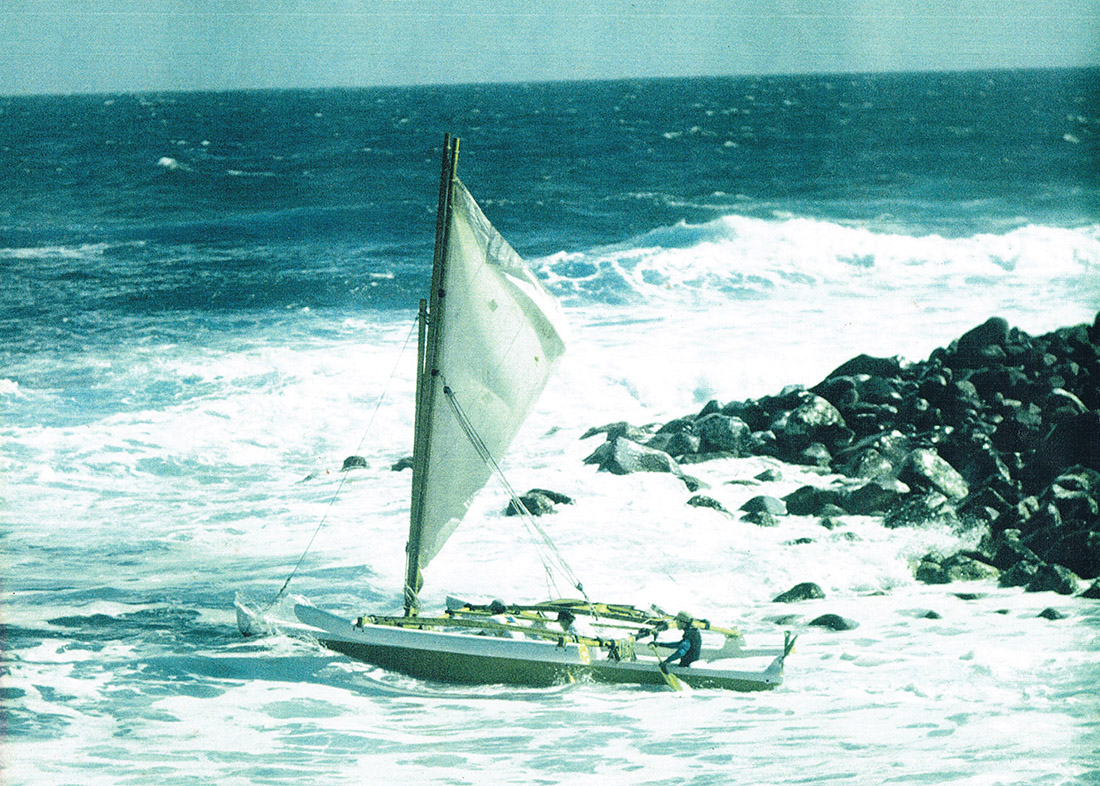
Foreign ships and interisland traffic increased greatly during the 1800s, with the sandalwood trade and then whaling, with more than 500 whaling ships calling at mid-century in Hawai‘i. The “workhorses” of interisland shipping were schooner-rigged, two masted vessels carrying passengers, cargo, and mail among the islands. The captured schooner Fair American had been the beginning of Kamehameha’s combined Hawaiian battle fleet in 1790, and soon there were numerous similar vessels in the commercial fleet, some constructed by Hawaiian shipwrights and owned by Hawaiian ali‘i. G. D. Gilman describes the typical interisland passage on one of these early packets 25 to 50 feet long: “Coming from windward was a comparatively easy matter, sailing before the wind. A day or two out coming from either Maui or Hawai‘i could be endured, but it was the homeward passage when beating up against the strong tradewinds, with all the nauseating effluvia that comes from the mixture of molasses and salt water, with all of the disagreeable adjuncts attending a miscellaneous cargo that the trials began.” Cargo included pigs, poultry, cattle and horses, tightly confined. Economy class passengers stayed with their mats on deck, and for a few who paid more, a crowded, stuffy cabin and a few bunks below were not much better. Yet during these times, Hawaiian canoes, both double and outrigger, were still crossing the channels among the islands.
A new era in speed, size, and comfort began with the arrival of such sailing vessels as the Maria, Kamoi, and later the Emma Rooke and Nettie Merrill. Emma Rooke, a handsome 97-foot long Baltimore clipper type, arrived in the islands in 1860, and on her maiden interisland voyage carried 60 passengers. Unfortunately, Emma Rooke was lost at Honoipu, North Kohala, in 1864, carrying a cargo of 600 kegs of sugar and 70 barrels of molasses, with no loss of life. Canoes were still lost too. On February 16, 1861, 27-year-old Kalia Nahulanui Parker, who had lost her beloved husband Ebenezer Parker, an heir to the growing Parker Ranch six years earlier, set out in a canoe from North Kohala to visit her family, an ali‘i clan on Maui. Kilia was never heard from again.
The landings on both sides of ‘Alenuihāhā channel tested the skill of schooner crews, who sailed in and out of these challenging spots in all weathers. Landings on the Hawai‘i side included Honoipu, Hapu‘u, and Keokea, and on the Maui side La Perouse, Nu‘u, and Hāna. Entering, offloading and loading passengers and freight were almost always risky. Losses of ships and lives were not uncommon.
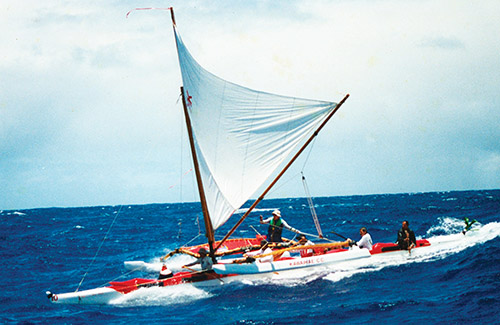
Steam began to supplant sail after the mid-1800s in Hawai‘i, although many vessels still kept their schooner rigs, which made them a bit faster, and also helped with stability in the rough channels. One example of the steam/sail schooner rig was the Likelike, a 592-ton wooden vessel built in 1877 for Hawaiian interisland service. Likelike also wrecked at Honoipu in 1897, from human error rather than weather. She was on a run across ‘Alenuihāhā from Maui to the Hāmākua landings under steam power and sail when she simply turned left too late to miss the North Kohala shore and proceed toward Hāmākua. Cargo and 1400 bags of Olowalu sugar were lost but no lives.
Navigation among the islands is always a challenge, especially in heavy weather and at night. There were no lighthouses on either side of the ‘Alenuihāhā channel until 1897, when an open 40-foot tower with a lamp room on top was constructed and put into service at Kauhola Point in North Kohala (somewhat central to the channel). The light could be seen at a distance of 10 miles. The current Coast Pilot states: “A dangerous reef, usually marked by breakers, extends 0.3 mile from Kauhola Point; passing vessels should give the point a berth of 2 miles.” Even today, the next light to the east is Kukuihaele, 14 miles away near Honoka‘a, and to the west at Māhukona, 11 miles down the coast from Kauhola.
On the Maui side of the channel, a light was established on the islet of Pu‘uki‘i near Hāna in 1909, and just around the western, leeward end of the channel at Cape Hanamanioa in 1918, replacing an earlier light closer to Makena.
As western vessels took over interisland travel and trade in the 1800s, fewer interisland Hawaiian canoes crossed the channels, and largely disappeared until modern times. With the rapid decline of the Hawaiian population from foreign diseases, and the suppression of Hawaiian culture and language, canoe use and travel greatly decreased. One bright spot was King David Kalākaua (1874-1891), and his strong support of Hawaiian culture, language, and ocean activities. Kalākaua encouraged all kinds of water sports, from rowboat races, to sailing and canoe races, from his boathouse, Healani, on Honolulu harbor.
Outrigger paddling and surfing became somewhat popular again in the early 1900s with early tourism at Waikīkī and canoe clubs such as Outrigger and Hui Nalu. It was not until much later that canoe culture really grew again, after the first modern outrigger crossing of the Moloka‘i channel in 1952, and the founding of the Polynesian Voyaging Society in 1973.

Today, outrigger canoes paddle and sail all the Hawaiian channels, including the ‘Alenuihāhā. The first crossing of a wahine (women’s) crew was in 2004, when Kawaihae Canoe Club paddlers left from ancient Honoipu landing and arrived at Nu‘u landing on Maui. The Hawaiian Canoe Sailing Association conducts interisland outrigger sailing races annually across the channels connecting the islands.
The ‘Alenuihāhā channel continues to challenge mariners as it has for centuries, and usually provides valuable, and sobering experience in heavy weather seamanship. ❖
Contact writer Pete Hendricks: oldsaltp@yahoo.com
